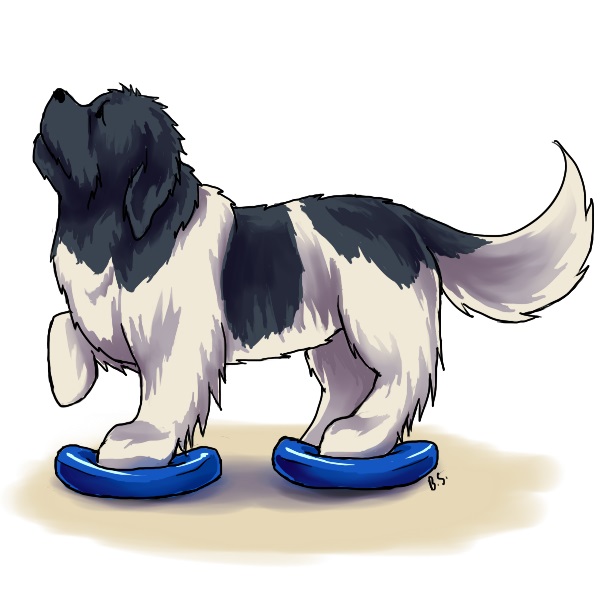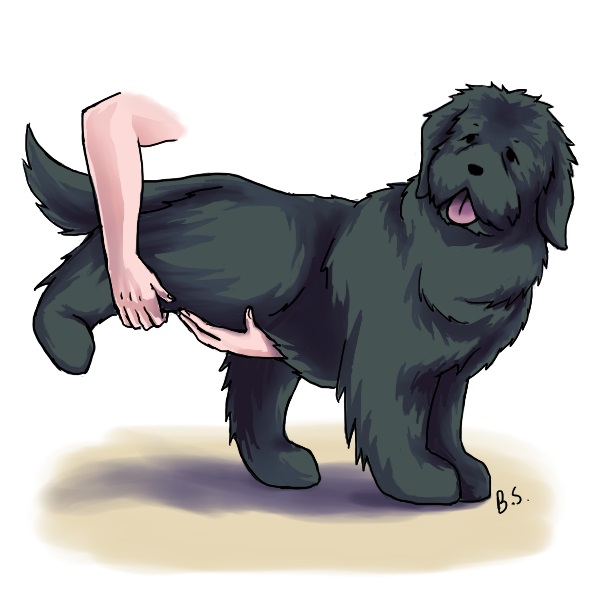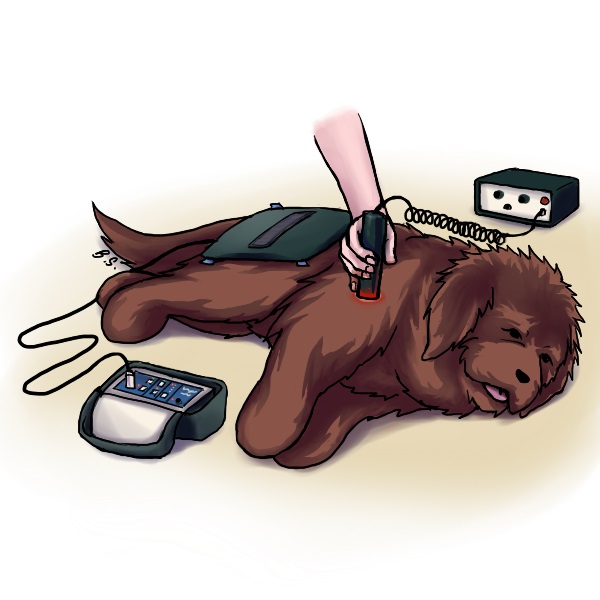What
is veterinary physiotherapy?
Veterinary
physiotherapy aims to reduce pain, optimize tissue healing, restore
movement, improve gait, improve muscle strength and tone, and improve
function. It is an ideal form of treatment to be used alongside
veterinary medicine to rehabilitate and condition dogs. Each veterinary
physiotherapy programme will be tailored to the individual to achieve
the best possible outcome.
A dog does not have to have a
diagnosed condition when referred for veterinary physiotherapy.
Veterinary physiotherapy can help in everyday living for all dogs, and
it can be a good idea to get your dog checked out yearly to ensure any
developing issues are caught early.

For
example conformation (how the dog is structurally built) will influence
its muscle loading during stance and movement. Even small differences
will affect the way the muscles are strengthened and can result in
tight muscles with restricted range of motion. This can alter bone
alignment, and in the long term can cause an increased incidence of
osteoarthritis in the joints. With physiotherapy exercises can be
prescribed to change the dog's movement patterns and to build up the
dog's muscles evenly. Soft tissue manipulation and electrotherapies
will be able to
help reduce muscle tightness and improve joint range of motion. Overall
the dog will be able to move more freely, have improved range of
motion, reduced discomfort from chronically tight muscles and more
evenly built muscles which will help the dog live a long healthy life.
What
cases can be treated?
1.) Musculoskeletal issues from trauma or overuse
- soft tissue injuries such as sprains or strains
- joint injuries (managing chronic athritis)
- bone injuries (improving healing rate and return to function)
- chronic inflammation, bursitis, tendonitis
- hyperirritable areas of muscle
- over/under built muscles with abnormal muscle tones
- tissue injuries with an aim to minimize acute inflammation, tissue damage and size of scar
2.) Post-orthopaedic surgery to maximize the success of surgery and optimize recovery
- wound management with minimal scarring
- improving range of motion and safe return to function
- controlled weight bearing exercises
- symmetrical muscle building
- pain management
Veterinary
physiotherapy is ideal for post cranial cruciate surgery (TTA, TPLO, TR/LS), patella luxation surgery, total hip
replacement, femoral head and neck osteotomy and many more. It is also an important part of conservative management of chronic arthritis (elbow dysplasia, hip dysplasia). 
3.)
Genetic/developmental conditions
- safe and controlled weight loading and muscle building
- relief from chronic muscle tightness
- improve quality of life and prevent further problems or surgeries
- pain relief
Veterinary
physiotherapy is ideal for managing hip and elbow dysplasia and
conditions such as osteochronditis dissecans (OCD)
4.) Neurological deficits from trauma
or degenerative conditions
- improve proprioception (body awareness and limb placement)
- improve co-ordination and balance
- slow the progression of degenerative neurological conditions
- improve the functionality of the animal
- mental stimulation
Veterinary
physiotherapy is ideal for intervertebral disc disease (IVDD), degenerative myelopathy (DM), lumbosacral conditions, caudal cervical spondylomyelopathy (wobbler's), chronic degenerative radiculomyelopathy
(CDRM), fibrocartilaginous embolism
(FCE) and many more...
5.) Working dog
conditioning
- preparation of the dog for athletic activity, skill training and
cardiovascular training
-
pre-season checks will allow for early recognition of future issues,
allowing for targeted exercise prescription during the season to
prevent issues developing during the working season
-
targeted exercise prescriptions for conditioning the animal to be in
top shape for the specific sport. Different sports place different
demands on the animal's body. The endurance of waterwork recruits
different muscles, skills and cardiovascular effort than the speed and
precision of agility.
Reduced
performance, refusal and behaviour changes are indications that the dog
may have underlying issues which need to be addressed.
6.) Elderly dogs
- improve the quality of life and increase mental stimulation
- improve and maintain range of motion
- relax chronically tight muscles
- pain relief for chronic issues
- safe exercises to increase and maintain muscle condition
Veterinary
physiotherapy on an ongoing basis is ideal for elderly dogs who often
suffer from small, chronic issues such as osteoarthritis (elbow dysplasia, hip dysplasia) or increased
muscle tension. With a physiotherapy programme, the small aches and
pains can be managed improving your dog's quality of life.
7.) Respiratory deficiencies post anesthesia or from neurological causes
- manage secretions and aid breathing
What
modalities are available? 
1.)
Electrotherapies
- Pulsed
Electromagnetic Field Therapy (PEMFT)
- Phototherapy
(Low Level Light Therapy)
-
Transcutaneous electrical nerve stimulation (TENS)
- Neuromuscular electrical stimulation (NMES)
2.) Soft tissue
manipulations and range of motion
-
Massage
-
Myofascial release
- Passive and
active stretches
- Passive and
active range of motion
3.) Cryotherapy
and thermotherapy
4.) Exercise
prescription including proprioceptive enhancements
Can
I be sure that my dog will improve with veterinary physiotherapy?
While
complete recovery and return to function cannot be guaranteed, I will
work my hardest to ensure the best possible outcome. During our
appointments I will go through the treatment plan and realistic goals
with you and if any modifications are made, I will keep you informed
throughout. |